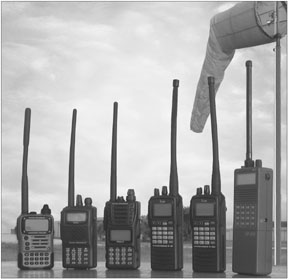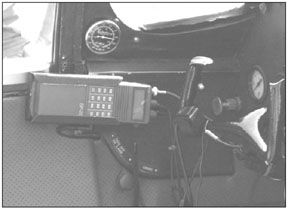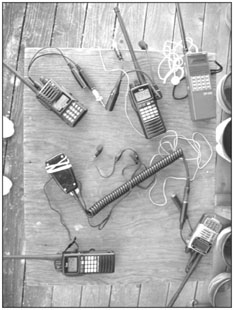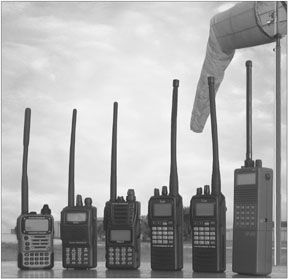
by Chuck Forsberg
In the world of portable avionics, GPS navigators are the stars while VHF radios are the bench warmers. Yet every pilot we know has a portable comm radio, even if its rarely used. Its the sort of basic equipment everyone seems to carry in a flightbag, like a pad or flashlight.
Why? Back-up communication is the reason most of us have VHF portables.Call this standby mode, if you like. Youll probably never need it, but for a couple of hundred bucks, you can have a radio to lean on if the panel goes dark during an IFR flight. Ground ops and pre-flight are another good reason for having a handheld. Weve all seen linemen with handhelds at FBOs and fly-ins and it seems silly not to be able to communicate with them, if the need arises. For airplanes with no electrical systems, a battery-powered portable can provide communications for flights into busy airspace where a radio is a must.
In the not-so-distant past, the VHF market was all but dominated by the Japanese electronic giant, ICOM. But competition in this narrow market segment has intensified, yielding price competition and radios with more features. Some years ago, even Sportys got into the act, with a well-regarded portable radio first made by Japan Air Lines.
For this article, weve reviewed what we consider to be the six top contenders in the aviation VHF market, including ICOMs IC-A6 and IC-A24, the Sportys SP-200, and the VXA-210, -300 and -700 models. There are others to pick from but, frankly, we think these six are so price competitive and capable that any buyer will have no trouble finding a model to suit at an attractive price point. Speaking of price, they vary somewhat, according to vendor. At the high end is the ICOM IC-A24 at $390 discounted-its a full-up navcomm-while the Vertex Standard VXA-210 is a compact comm-only unit that sells for $230 to $260, typically. All the other products fit between these two price points.
Although our testing for this article is relatively comprehensive, choosing a radio should be defined by what features you want and how we’ll the radio meets these requirements. Do you really need, for instance, 20 memory channels, automatic scanning and a built-in VOR? Our guess is probably not.With that mind, our top criteria for best value lean toward solid comm performance, easy-to-understand features and controls and a reliable, convenient battery charging system.
How We Tested
We obtained sample ICOM and Vertex radios through the courtesy of Gulf Coast Avionics (www.gulfcoastavionics.com) and, directly from Sportys, an SP-200. We examined and photographed each one and tested real-world performance of both the comm section and-if so equipped-the VOR section in both the air and on the ground. Using properly calibrated test equipment, we looked at things like current drain and battery life, transmitter output power, comm sensitivity and so on. Our goal was to sketch a general picture of the technical competence of each receiver without getting too wrapped up in the finer points. We think features and operability of the radios are the primary determinant of value and should drive the purchase decision as much as technical performance.
ICOM IC-A6 and IC-A24
Among all the radios handled by various pilots during this review, these two proved the most popular. And with good reason. Theyre solidly made, with nice tactile feel and small size. Theyre fairly simple to use, which is a plus for something that might come out of your flightbag once a year, if that.
The two models are essentially identical, except the A24 has a VOR function and the A6 is comm only. Both share identical manuals and accessories, too. These radios have a top-mounted volume control, a large multi-purpose knob and a standard BNC antenna connector. An adaptor cable for external microphone and headphone attaches to the weather protected connectors on the right side of the radio. This cable has a redundant mini-jack to connect to a push-to-talk switch.
There’s a NOAA weather-alert monitor which can be operated from the wall-hugger power supply with the battery removed. This is important, given that the battery must not be recharged for more than 12 hours at a time. Only the A6 and A24 have the ability to monitor NOAA weather alerts when tuned to a comm frequency.
Although we like the alkaline packs, we think they could use some design work. We find it difficult to remove the pack and change the batteries, a bad thing if you have to do it in flight under duress. In an airplane where the ICOMs might do duty as primary navcomms, the cigarette lighter cable operates the radio or recharges from 12 and 24 volts.
Although earlier aviation handhelds tended to be tender, these newer radios are designed to be submersible according to the JIS-4 standard, which means theyre supposed to resist one hour of driving rain.
Although the IC-A24 is technically a navcomm, it has no localizer and compared to the Sportys SP-200, it doesnt do a good job of extracting usable navigation information from a marginal VOR signal, which is often the case when only a portable antenna is available. We found that ignition noise interferes with the VOR demodulator. Even with the engine stopped, clicks from a strobe beacon disrupted VOR readings. On the comm side, the ICOM radios revealed no birdies-strange squeals, pops or snaps-and the audio quality is good.
The ICOMs have the largest and easiest-to-read frequency display, clearly readable from most angles. This, the weatherproofing and supplied headset adapter, make ICOM the choice for aircraft without avionics. But for top performance, plan on installing an external antenna.

Sportys SP-200
Although were not privy to the sales numbers, we wouldnt be surprised if this radio is the market leader in volume. Its inexpensive-$299 directly from Sportys-performs we’ll and is easy to use, which is to say it hits all the high notes effectively, even if its not as good as the other radios in certain performance characteristics.
The SP-200s boxy appearance is dominated by the large battery pack. The battery pack can be removed when optional external power is used. This radio is the largest of the lot, thanks to the eight AA battery pack. But with antenna attached, there isn’t that much difference in size between these radios, so who cares? The extra batteries give the Sportys a decided edge in transmit time endurance. Sportys has a long list of optional accessories for this radio, including headset adapter, antenna coupler, spare battery case and a NiCad rechargeable battery pack and charger system. There’s also a ships power accessory for 12- , 24- and 28-volt options.
The SP-200s form factor has top-mounted squelch and power/volume controls, a flip-flop memory button and standard BNC antenna connector.External mic and phone connectors are on the top and are not weather protected, as with the ICOMs. The SP-200 is the only radio we tested that doesnt have keyboard beep, except for illegal keys. This is a bit of a nuisance if youre used to a beep or tactile feedback but its offset by the slightly larger keyboard, which reduces fat-finger mistakes. The SP-200 tunes up to 142.975 MHz in 8.33 KHz steps.
Sportys was the best of the group in VOR performance, hands down. In a pinch, you could actually navigate with it. Further, its the only portable radio that displays a LOC signal, something that might come in handy some day. The VOR mode automatically sets a course TO the VOR as soon as the VOR signal is decoded, although the initial course is sometimes inaccurate. When this happens, change frequency momentarily to force a retrain.
During comm band scan, nine birdies were detected at an aggressive squelch setting. Turning up the squelch eliminated them. The birdies don’t seem as strong as the birdie on the VXA-700. Squelch level is controlled by a real knob, not keys or sliders. Frequency display and CDI are easy to read in the handheld position-antenna pointing slightly away from you and the display is optimized for this angle of view. Contrast is poor when viewed from above, as would be the case if the radio were attached to the panel. Overall, for the price, the Sportys SP-200 offers a lot of value and plenty of add-on accessories.
Vertex Radios
Among amateur radio enthusiasts, Yaesu is a well-known Japanese brand and Vertex Standard is the new name for that line. Building on its experience with portables for hams, Vertex markets three radios for aviation use, the VXA-210, the VXA-300 navcomm and the VXA-700, which combines navcomm functions with 2-meter amateur band capability.
All of the Vertex products share some common traits, such as a dot-matrix display, magnesium die-cast construction and rechargeable batteries as the standard power source. All of the Vertex radios use a screw-in SMA antenna connector.
This saves a bit of space but sacrifices compatibility with other avionics connectors. The Vertex radios have a battery saver feature that works by hibernating the receiver when no signal is present, waking up at times to check the frequency. This seems likes a good idea, but it means that the beginning of a transmission may be missed, an annoyance.
As we go to press, the VX-210 may be about to be discontinued. Were not sure because Vertex Standard is, in our view, terrible at sales, marketing and support. They declined to provide sample radios and couldnt be bothered to return our query calls. In our view, this kind of lack of response is unacceptable in the competitive environment in which these radios live.
The VX-210 has a large power/volume control and a multifunction knob.Depressing the multifunction knob combines with a function key to navigate its menu system. An unmarked multilevel menu system must be negotiated to adjust squelch. The radios 700 MaH NiCD battery gave it the shortest battery life of all the units tested, so powering with optional alkalines is the way to go. An optional alkaline pack holds six cells. Performance-wise, the radio proved susceptible to cross modulation, which harms signal reception quality. The VXA-210 receives weather but has no weather alert.
Vertex Pilot VXA-300
The VXA-300 is similar in design to the VXA-210, with a top-mounted SMA antenna connector, screw-in external mike/headphone connector and concentric power/volume and multifunction knob. Menus are navigated by depressing the volume control and the function key. The 300 has a four-position tone control (pitch function) to optimize receiver intelligibility for various conditions, something unique and useful.
The receive channel step can be set to 8.33 kHz, but this disables the transmit function so were not sure how useful it is. The selectivity of this radio-and the others-isn’t up to the demands of 8.33 KHz spacing anyway. Its a neat bit of advertising but not useful, in our estimation.
As with the other Vertex radio, the keyboard lock doesnt prevent the large knob from changing frequency and during our modulation tests, we noted that like the less expensive VXA-210, the 300 also suffers from cross modulation. This radio, like the ICOMs, is claimed to be rain resistant according to the JIS-4 standard.
Vertex VXA-700
At $375 discounted, this radio is the most expensive of the group and its a gadgeteers delight, combining VHF aviation functions with a 2-meter amateur brand transceiver. If you find programming an IFR GPS a piece of cake, this is the radio for you. But in our view, the air band segment is mediocre, at best. The radio suffers from cross modulation, although not as badly as the VXA-300.
The VXA-700 comes standard with a custom form-fitting lithium ion battery and the transceiver itself is the smallest of this group of radios, with an antenna about the same size as the others. The power supply for charging the batteries is the largest of the group.
Between the cross modulation and mediocre VOR decoding, the VXA-700 had difficulty getting a bearing from the Newberg (UBG) VOR from Starks Twin Oaks airport, from which you can see the VOR antenna a scant five miles away.
There’s also a broadcast FM receiver aboard but we found that the reception was poor, with a tinny, mono sound thats just not impressive in an age of XM Radio and iPOD stereo. The VXA-700 seems to clip the beginning of incoming transmissions, even when the battery saver is disabled. There’s also a click or thump when squelch cuts in and out, which is annoyingly obvious when using headphones. We found a strong birdie at 122.325 MHz that interrupts scanning for weak signals.
Control-wise, the keypad is slightly smaller than the others and the 0 is in an annoying non-standard location. The large top knob is the easiest thing to disturb inadvertently. As with the other Vertex radios, the keyboard lock function doesnt prevent the large knob from changing frequency accidentally.An unmarked multilevel menu system must be negotiated to adjust squelch.

The optional alkaline battery holder for the VXA-700 holds two cells and doesnt allow transmitting. This oversight will be a deal breaker for many pilots. We were further turned off by the fact that the Vertex sales department returned none of our calls seeking additional technical information.
Recommendations
What to buy? First, what do you really need? A decade ago, a VHF portable with VOR capability was a must-have back-up for IFR. But now, portable GPS far outshines even panel-mount VOR units so for back-up nav, we say get a battery operated GPS. But if you still insist on VOR, the choice is relatively easy, in our view. Sportys SP-200 is the Alpha dog, hands down.The SP-200s VOR reception is better than any of the competing units and at $299, the radio is an excellent value.
But if you have GPS for back-up nav, the ICOM is a good choice for comm. The IC-A6 is small, rugged and has the choice of long-storage back-up with the alkaline battery pack. Weve seen it priced as low as $269, which makes it a bit cheaper than the SP-200.
With either of these two top radios, talk time can be extended with extra sets of inexpensive alkalines. The battery packs will also take a set of rechargeable AAs, as another option. (See Aviation Consumer, December 2004, for more on this topic.)
As for the Vertex radios, we found them to be a disappointment. The fact that the company simply wouldnt return our calls causes us to do something we rarely do: add these products to our don’t buy list. You can do better with Sportys and ICOM.
Also With This Article
“VHF Radios Compared”
“Batteries: Alkalines vs. Rechargeables”
-Chuck Forsberg is an electrical engineer and radio amateur. He owns a Cessna 182.





